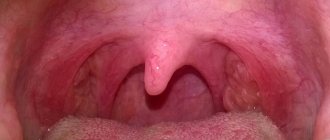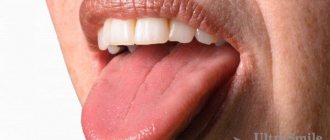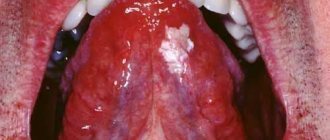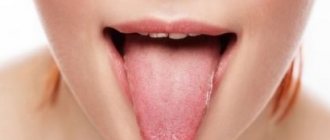We are used to the fact that we need to go to the dentist if we have problems with our teeth or gums. What to do if you have inflammation of the tongue or glossitis? Dentists identify more than 10 types and subtypes of infection. The infection can be caused by both fungus and bacteria. Viral infection is less common. Inflammation can be caused by a lack of certain vitamins and minerals, or hormonal changes. There are many reasons for the disease, so it is important to identify what exactly caused the inflammatory process.
Causes of glossitis
- improper oral hygiene;
- bacterial infection;
- fungal infection;
- heavy metal poisoning;
- bad habits (smoking, alcoholism);
- congenital pathologies of the tongue (folded tongue);
- allergic reaction;
- tongue injury (often caused by malocclusion);
- oral infections;
- lack of iron in the body;
- burn of the mucous membrane (hot food or drinks);
- infectious diseases (AIDS, tuberculosis, scarlet fever, measles).
Causes
Macroglossia can be either a local (local) manifestation or have a generalized nature. This disease can occur in many pathologies of the human body. As an independent disease, macroglossia can occur when:
- inflammation involving the lingual area (low glossitis of the tongue):
- rhinoscleroma with spread to the upper respiratory tract;
- open bite;
- acute angioedema;
- with the accumulation of pus due to an abscess in the oral cavity;
- a progressive cyst or tumor with damage to blood vessels (lymphatic or circulatory);
- hemorrhages accompanied by a rush of blood to the lingual tissue;
- “neurologically flaccid” tongue syndrome;
- impaired venous or lymphatic drainage in the lingual tissue;
- oral candidiasis.
However, macroglossia often occurs with such serious congenital damage to the body as:
- cretinism or other organic brain abnormalities;
- genetic disorders (Down syndrome, etc.);
- hypofunction of the thyroid gland and the development of myxedema;
- acromegaly.
Also, increased sizes of tongue tissue can accompany metabolic diseases such as:
- amyloidosis (deposition of amyloid in the tongue, when it becomes waxy, dense, with smoothed papillae);
- glycogenosis;
- pellagra (tongue red and ulcerated).
Often, forward displacement of the tongue can be observed in children as a consequence of their bad habit of tongue sucking.
Macroglossia is sometimes misdiagnosed in people with a small lower jaw.
The disease is often called “constitutional”, as it is common in obese men who have an increased love for food.
Macroglossia also occurs in severe infectious diseases such as tuberculosis or syphilis.
The most common types of glossitis
The most common occurrences in dental practice are:
- acute catarrhal glossitis;
- tongue abscess;
- desquamative glossitis.
Acute catarrhal glossitis is the most common type of inflammation. Inflammation can be caused by microbes or mechanical damage to the tongue. The predominant symptoms are pain, redness and swelling.
A tongue abscess is the appearance of an abscess in the tongue. The abscess can be superficial, under the mucous membrane, or maybe in the thickness of the tongue. Abscesses in the thickness of the tongue, in addition to pain in the tongue, can cause a disturbance in the general condition. A person develops a fever, a headache, and weakness. Most often occurs due to injury to the tongue.
Desquamative glossitis, also known as “geographic tongue,” most often appears in children. It appears in the form of various spots on the tongue, which look like a white coating, alternating with areas of pink mucous membrane. There are no changes other than appearance. Scientists have identified a clear reason for it. The main factors are believed to be bacteria, allergic reactions and hormonal imbalances.
Types of raids
The plaques that occasionally form on the surface of the tongue are very diverse. They differ in color, outline, and localization. Moreover, the color of the tongue and the disease are often directly related. In infectious pathologies, a dense whitish coating is usually observed that covers the entire surface. There is almost always a simultaneous increase in temperature.
If white deposits appear on the middle part of the tongue, and cracks form on the sides, then some pathological lesions of the stomach or intestines can be suspected. Having noticed the first manifestations, it is recommended to change the diet to a more easily digestible one, limiting salt and fat. The appearance of pain indicates the need for emergency examination by a doctor.
White deposits that appear on the front of the organ are evidence of problems with the respiratory system, with the most common cause being tobacco smoking. At the same time, sometimes a person’s speech changes tonality. Developing dysbacteriosis often leads to a fungal infection, manifested in particular by the appearance of whitish spots on the entire surface. Quite often it develops as a result of improper treatment with antibiotics.
An alarming signal is the appearance of a red and white spotted coating. This is what the symptoms of scarlet fever look like. Having noticed such formations, you should immediately seek medical advice; a timely and effective treatment method will allow you to quickly get rid of the pathology without any consequences.
If your tongue turns yellow, you should pay attention to the amount of deposits. A small amount of yellowish plaque should usually not cause concern. However, the intensive formation of a thick layer allows one to suspect the presence of foci of inflammation inside the gallbladder. In this case, you should pay attention to the presence of unpleasant sensations under the ribs on the right side. These are the signs of developing cholecystitis.
A burgundy coating over time turning into a brown crust often indicates food poisoning. If it is small and passes quickly enough, then coloring can occur due to the use of food (natural) dyes, for example, chocolate or coffee. The prolonged presence of such deposits usually indicates dysbacteriosis.
Symptoms of glossitis
- increased salivation;
- swelling and redness;
- pain and burning when eating;
- plaque on the tongue in the form of spots;
- bad breath;
- papillomas or warts on the tongue;
- speech disorder;
- foreign body sensation.
Prevention of glossitis - high-quality oral hygiene and no bad habits. It is important to undergo timely preventive examinations and also eat well. All these factors actively contribute to the development of the disease and bring a number of problems.
Blue plaque in a child
Every young mother needs to make a daily morning examination of her child’s mouth a mandatory procedure. It should be borne in mind that a small whitish layer, which is easily removed by hygiene procedures or disappears on its own after eating, is the norm. But the appearance of a thick layer or a change in color should cause serious concern.
It is especially necessary to react quickly to a child’s blue tongue. Why should the blue tint of the tongue attract such increased attention? This shade serves as one of the main signals that can reflect the occurrence of a number of pathological problems that begin to progress in the important organs of the child. With such a change in color, problems with the respiratory system, heart (arrhythmias, angina pectoris, etc.), circulatory system, and kidneys can be suspected.
In such a situation, parents are advised to immediately consult a doctor. Young children are not always able to fully describe the sensations that arise, and young parents are not always able to correctly identify what the child is describing. That is why such an important signal should encourage parents to visit a medical facility. Another reason for a blue tongue in a small child may be disorders of the nervous system. With such problems, seizures or cerebrovascular accidents are usually observed simultaneously.
Treatment of glossitis
A specialist must make an accurate diagnosis and identify the cause of the disease. If you suspect that you have glossitis , and all symptoms indicate this, contact your dental clinic. This is the only way to create the right treatment plan and provide timely assistance. Quite often in such cases, doctors prescribe antibiotics, anti-inflammatory drugs and rinsing the mouth with special antiseptic solutions. In advanced stages, glossitis is treated surgically. Deep abscesses must be opened in the maxillofacial department. Under no circumstances should you take medications without a doctor’s recommendation.
You can cure glossitis, caries or any other diseases of the oral cavity right in your sleep. Family Dentistry Center "Medexpert" provides dental treatment under medicinal sedation. Thanks to this approach, the patient falls into a healthy sleep, ceases to feel pain and discomfort, while the vital functions of the body remain unchanged. Sedation is widely used in pediatric dentistry and even helps fight dental phobia. Dental treatment can be comfortable and painless - tested for yourself.
Symptoms
Macroglossia can be true or false. Sometimes abnormal development of the jaw arch is mistaken for an increase in lingual tissue. In case of recession or congenital narrowness of the jaw, this ailment is considered false. With true macroglossia, the tongue is enlarged by one and a half to two times. However, this form of the disease occurs rarely.
Macroglossia in newborns
It is important to identify this disease in a timely manner, as this will greatly affect the success of its treatment and the likelihood of it becoming chronic.
Therefore, it is especially important to identify such pathology during the neonatal period.
When examining a newborn, it is important not to miss such manifestations of the disease as:
- enlargement of the tongue when it protrudes beyond the mouth;
- “varnished” or dried surface;
- tuberosity, enlarged papillae;
- blocking of the larynx by the root of the tongue, which forces the baby to refuse food;
- slightly open mouth;
- labored breathing;
- excessive salivation;
- frequent attacks of asphyxia (breathing problems);
- frequent infection and increased body temperature;
- deterioration of general condition.
Very often, children in the first year of life experience a local form of the disease. Often tongue pathology occurs in the fetus for the following reasons:
- improper development;
- idiopathic diseases with symptoms of hypertrophy of the lingual muscles;
- the formation of cysts or cavities during the formation of the tongue muscles;
- with adverse factors affecting the pregnant woman’s body (intoxication, radiation, infections).
Where to find?
Where exactly to find the pale tongue in Dark souls 3 depends on whether you are ready to invade other worlds or not:
In single player
In this case, there are several options for how to obtain a pale tongue:
- find on location,
- knock out of the enemy.
Undead Settlement
You need to search in the part of the location where the battle with the Demon (DS 3 mini-boss) takes place along with Siegward. In a small area near the fireplace there are two corpses hanging, which can be knocked down with a ranged attack or climbed along the roofs. The desired item will drop from one of them.
After the demon is killed, the path to the hanging corpses is clear
Temple of the Depths
In the Temple of the Depths, you can take a pale tongue in two places at once:
- At the feet of the sleeping giant is a slave near the rise to the boss Deacons of the Deep.
- At the end of the roof on a corpse if you go up to the top of the temple. This path leads to the Rosary. You can get up here on a lift from the “Chapel of Purification” bonfire.
The sought-after giant
From this roof there are 2 passages to the dome at once
From the bodies of killed enemies
In addition, with a small chance it drops from an enemy called a dark spirit. They are found in several places:
- Farron Citadel.
- High Wall of Lothric.
- Before the entrance to the boss Guardians of the Abyss (location “Path of Sacrifices” bonfire “Border of the Farron Citadel”). They initially do not pay attention to the main character, but go to kill the Husks.
This is what the Dark Spirit looks like
Online mode
In many ways, the pale tongue in DS 3 is an online mode item, for this reason, it is 100% likely to drop in the following cases:
- After successfully invading the world of other players while in the covenant of the Fingers of the Rosary.
- After defeating other players without being in the Fingers of the Rosary.
But to get the artifact you will have to kill other players
Causes
What makes a tongue purple? A change in the normal (pink) color of the tongue to violet or purple (uniform or patchy) can be due to a large number of reasons. Let's look at a number of the most common ones.
Circulatory disorders
The first possible reason for the purple coloration of the tongue is impaired blood circulation.
Occurs as a result:
- heart disease;
- peripheral arterial diseases, in particular Raynaud's disease;
- thrombosis;
- varicose veins;
- diabetes;
- obesity, etc.
In this case, other signs of the disease appear, for example, numbness, pain, muscle cramps, a burning sensation and pain in the legs that passes during walking, as well as tingling in various parts of the body.
Nutrient deficiency
Lack of vitamins is another common cause of a purple tongue. Most often, it indicates a deficiency of riboflavin (vitamin B2). However, this is not the most important sign of ariboflavinosis (a disease that occurs due to a lack of this vitamin).
If you have this condition, you are likely to have other symptoms:
- stomatitis (inflammatory changes in the oral mucosa);
- soreness and redness of the tongue;
- pharyngitis, sore throat;
- cracks on the lips.
Also, deficiency of vitamin B12 and folic acid can cause the tongue to change color to reddish-purple.
If the discoloration is due to poor nutrition, make sure you eat enough foods rich in these vitamins.
In particular:
- eggs;
- meat;
- fish;
- hard cheeses;
- green leafy vegetables;
- fermented milk products (yogurt, sour cream, cottage cheese).
Respiratory diseases
Diseases of the respiratory system that affect the supply of oxygen to the blood can cause the tongue to appear purple, especially dark purple or bluish. This is accompanied by the appearance of a bluish-purple tint to the skin and veins.
The presence of symptoms increases the likelihood that the problem is respiratory related:
- wheezing (audible at a distance or heard by a doctor);
- feeling of lack of air (shortness of breath);
- “a persistent cough that produces mucus (phlegm)” [nhs.uk];
- frequent colds or exacerbations of diseases of the bronchi and lungs with increased body temperature.
High cholesterol
Many naturopaths associate the problem of purple tongue with high cholesterol levels. This sign of a disorder in lipid (fat) metabolism in the body is often the cause of heart disease and deterioration of general blood circulation.
Injury
Serious trauma, including tongue biting or piercing, can cause purple discoloration. In this case, you will have an inflamed, swollen, painful purple tongue.
Other reasons:
- disorders of the digestive system;
- weakening of the drainage (cleansing) function of the lymphatic system,
- pathology of blood vessels;
- a weak immune system, especially in people with diseases such as AIDS or severe, untreated diabetes;
- nutritional problems: pellagra (lack of vitamin PP), sprue (deficiency of vitamin B12 caused by intestinal diseases) and pernicious B12-deficiency anemia, Plummer-Vinson syndrome (pathology of the digestive organs due to iron deficiency) - will cause a reddish shade of purple;
- long-term use of certain medications (most often antibiotics), allergic reaction to any food or medications;
- the consumption of certain fruits and vegetables, such as beets, grapes, pomegranates, as well as products with coloring additives (chewing gum, sweets, juices) lead to a temporary change in the color of the tongue;
- accumulation of food debris in the oral cavity (on the gums, near the teeth), and the growth of bacteria;
- smoking (not only the tongue, but also the lips can change color);
- long-term inflammatory processes in the tongue.
History of pathology
With atrophy and smoothing of the filiform papillae, the surface of the tongue resembles polished. These are the first signs of glossitis - an inflammatory disease of the muscle organ. There are several types of pathology according to the factors of appearance and clinical manifestations: rhomboid, folded and desquamative.
If the tongue is smooth, it means that the patient has encountered non-infectious Günther-Miller glossitis. The pathology was named after the doctors who first described the clinical manifestations of the disease in their works. The syndrome was first mentioned in 1851.
Consequences of macroglossia
Sometimes patients do not perceive macroglossia as a serious pathology and do not contact specialists in a timely manner. However, such a defect in the body as a large tongue can cause a person a lot of inconvenience and serious complications. First of all, the condition of the patient’s dentition is seriously disturbed. The tongue itself suffers from excessive dryness and is often injured and inflamed.
Also, an enlarged tongue interferes with the normal socialization of children, being a cosmetic defect. Most patients acquire psychological complexes.
After all, not all of their peers are ready to be friends with children whose tongues stick out, their speech is slurred, and there is also a constant flow of saliva from their mouths.
However, this is not all. With a long course, the disease often leads to the following pathologies of the body:
- breathing problems and the habit of breathing through the mouth;
- problems with diction (especially pronouncing hissing sounds);
- violation of the formation of the dentofacial apparatus with pathologies of the formation of dentition;
- digestive problems (the appearance of ulcers, colitis and gastritis) due to difficulties in chewing food.
In addition, an untreated disease causes pain and constant discomfort in the mouth. The tongue is inflamed, enlarged, stiff, and even subject to constant biting.
Reason in Chinese traditional medicine
According to Chinese medicine experts, the presence of a purple tongue may indicate either excessive heat and decreased fluid (i.e., internal dryness) in the body (due to increased heat production), or a so-called cold condition, which causes “stagnation of blood.” poor circulation, elevated sugar levels, leaving you feeling tired and cold inside.”[dailymail.co.uk]. A likely cause of this problem may be the consumption of cooling (mainly Yin) foods. You should make sure you have warming (yang) ingredients in your diet, such as ginger, coriander, cinnamon and horseradish.
Chinese Medicine Basics Regarding Purple Tongue:
- If you have a greenish or bluish-purple or light purple tongue, there is probably stagnation of blood in the body and internal cold prevails in the body.
- A dark reddish-purple color indicates that your body is losing fluid (internal dryness) due to excessive heat, and your body is stagnating due to internal heat.
- A light purple hue indicates that you probably have a dominant internal wind.
There are many other diseases and syndromes that can cause a purple tongue. It is important to consult a qualified doctor in time, who will not only make the correct diagnosis, but also prescribe adequate treatment.
What is it needed for
In Dark Souls 3, a pale tongue will be needed for several things at once:
- Increase your level in the Fingers of the Rosary covenant.
- Receiving the Key to the hall with the lift for the battle with the dark spirit from Leonhard. To do this, you must have at least 1 pale tongue in your inventory.
- Changes in the appearance and parameters of Rosaria, the mother of rebirth in the Temple of the Deep.
For this reason, if you want to do one of the things listed above, you need to find an artifact somewhere. We'll talk about this a little below.





